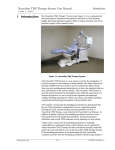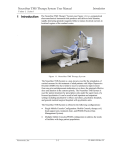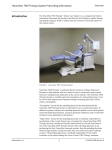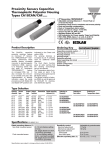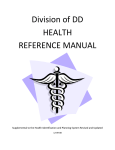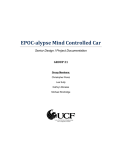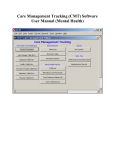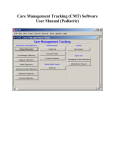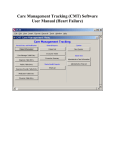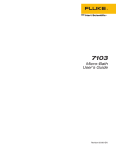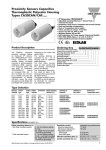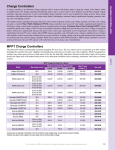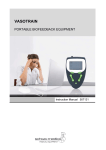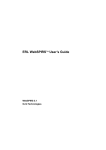Download NeuroStar TMS Therapy System User Manual
Transcript
NeuroStar TMS Therapy System User Manual Volume 1, Section 1 1 Introduction Introduction The NeuroStar TMS Therapy System (see Figure 1-1) is a computerized electromechanical instrument that produces and delivers brief duration, rapidly alternating (pulsed) magnetic fields to induce electrical currents in localized regions of the cerebral cortex. Fig u re 1-1. Ne u ro S ta r TMS Th e ra p y S ys te m The NeuroStar TMS Therapy System is a non-invasive tool for the stimulation of cortical neurons for the treatment of adult patients with Major Depressive Disorder (MDD) who have failed to achieve satisfactory improvement from one prior antidepressant medication at or above the minimal effective dose and duration in the current episode. The NeuroStar TMS Therapy System is used for patient treatment by prescription only under the supervision of a licensed psychiatrist. It can be used in both inpatient and outpatient settings including psychiatrist’s offices and clinics, psychiatric hospitals, and general medical/surgical hospitals with psychiatric units. “Prescription” means that the attending psychiatrist has determined that the use of the NeuroStar is indicated for use in a particular patient, utilizing the FDA-cleared labeling, including benefits and risk of NeuroStar TMS Therapy, as provided in the NeuroStar User Manual. In addition to patient selection, the attending psychiatrist should oversee initial patient motor threshold determinations, treatment parameter definitions and overall TMS treatment course planning for each patient. “Supervision” means that the attending psychiatrist is medically responsible for coordination of the overall clinical care of a patient for whom NeuroStar TMS Therapy has been considered clinically indicated and for the safe and effective use of the NeuroStar TMS Therapy System. Neuronetics, Inc. 1-1 52-40023-020 Rev. A NeuroStar TMS Therapy System User Manual Volume 1, Section 1 Introduction If the attending psychiatrist is not performing the daily NeuroStar treatment sessions, then the attending psychiatrist should assign properly trained personnel who may perform the daily treatment sessions. The attending psychiatrist is medically responsible for the routine psychiatric and medical evaluation of the patient during the course of their TMS Therapy treatment. The NeuroStar TMS Therapy System is offered in the following configurations: 1.1 Ove rview • Single mobile console configuration: mobile console, treatment coil, head support system, treatment chair, and TMS TrakStar practice data management system. • Multiple mobile consoles/TMS TrakStar system configurations to address the needs of facilities with large patient populations. Since the NeuroStar TMS Therapy System produces a time varying magnetic field, its intended effect derives fundamentally from Faraday’s Law, which asserts that a time-varying magnetic field produces an electrical current in an adjacent conductive substance. During TMS, the conductive substance of interest is the brain, in particular the region of the cortex that lies beneath the NeuroStar TMS Therapy System treatment coil. The electric current induced in this region of the cortex travels in a path orthogonal to the direction of the alternating magnetic field with the point of maximum field strength and greatest current located directly beneath the center of the coil, which is the NeuroStar TMS Therapy System component that rests against the patient’s head and transmits magnetic pulses to the patient’s brain. The induced current is tangential to the scalp at the cortical surface, and diminishes in magnitude with increasing depth. In the targeted area of the motor cortex, where field strength achieves the stimulation threshold, it is postulated that neuronal depolarization occurs. This type of magnetic field is not intended to induce a seizure during therapeutic use. The peak magnetic field strength achieved with each pulse in the cortex is approximately 0.5 Tesla. Although the mechanism of action is unknown, it is hypothesized that the NeuroStar TMS Therapy System causes neuronal depolarization and changes in brain functional activity that may be associated with various physiologic changes in the brain associated with symptomatic relief of depression in the indicated population. Neuronetics, Inc. 1-2 52-40023-020 Rev. A NeuroStar TMS Therapy System User Manual Introduction Volume 1, Section 1 1.2 In d ic a tio n s Clin ic al Trials NeuroStar TMS Therapy is indicated for the treatment of Major Depressive Disorder in adult patients who have failed to achieve satisfactory improvement from one prior antidepressant medication at or above the minimal effective dose and duration in the current episode. The safety and efficacy of NeuroStar TMS Therapy in Major Depressive Disorder (MDD) was studied in a randomized controlled trial of patients who had failed to receive benefit from one to four prior antidepressant medications. While effectiveness was not demonstrated for the overall study population (N=301 patients, P=0.057 on the primary efficacy endpoint, MADRS change from baseline at 4 weeks of treatment), a retrospective subgroup analysis of the overall study population demonstrated that the device was safe and effective for patients who had failed one, but not more than one, antidepressant medication (N=164 patients, P=0.0006 on the primary efficacy endpoint, MADRS change from baseline at 4 weeks of treatment). Efficacy of the NeuroStar TMS Therapy System was not established for patients who have failed to receive satisfactory clinical improvement from two or more antidepressant medications given at or above the minimal effective dose and duration in the current episode See Table 1-1. Ta b le 1-1. P rim a ry Effic a c y Ou tc o m e (MADRS ) fo r Ove ra ll S tu d y P o p u la tio n a n d b y ATHF Le ve l (1-4) MADRS Total Score Active Treatment N (%) 155 (100%) 88 (57%) 45 (29%) 15 (10%) 7 (5%) Overall Sample ATHF Group 1 ATHF Group 2 ATHF Group 3 ATHF Group 4 1 Sham Treatment N (%) 146 (100%) 76 (52%) 50 (34%) 15 (10%) 5 (3%) P-Value1 0.057 0.0006 0.710 0.588 0.022 P value represents the contrast between active and sham treatment conditions at the primary efficacy time point (week 4, LOCF analysis). The retrospective subgroup analysis was based on a six-week randomized, sham-controlled clinical trial in outpatients, ages 18 to 70 years, meeting DSM-IV diagnostic criteria for MDD who failed to achieve satisfactory improvement from one prior adequate antidepressant medication in the current episode and who were moderately to severely symptomatic. The majority of patients in this (ATHF1) subgroup (~97%) had recurrent courses of major depression with the duration of the current episode of depression of ≤ 3 years. Patients had received a median of 4 total prior antidepressant medication attempts in the current episode, one of which achieved treatment adequacy at or above the minimal effective dose and duration. In clinical trials, medication adequacy was determined using the Antidepressant Treatment History Form (ATHF), which identified those medications given at or above the minimal effective dose and duration as Neuronetics, Inc. 1-3 52-40023-020 Rev. A NeuroStar TMS Therapy System User Manual Volume 1, Section 1 Introduction defined in the product labeling. Failure of benefit was defined as no more than a minimal clinical response to the antidepressant medication as assessed by the clinician. In cases where patients were untreated or insufficiently treated in the current episode, the medication history from the most recent prior episode was utilized to determine medication adequacy. A major depressive episode as defined in the DSM-IV implies a prominent and relatively persistent (nearly every day for at least two weeks) depressed or dysphoric mood that represents a change from previous functioning, and includes at least five of the following nine symptoms, one of which is either of the first two symptoms: 1.3 Co n tra in d ic a tio n s • Depressed mood • Markedly diminished interest or pleasure in usual activities • Significant change in weight and/or appetite • Insomnia or hypersomnia • Psychomotor agitation or retardation • Fatigue or loss of energy • Feelings of worthlessness or excessive or inappropriate guilt • Slowed thinking or impaired concentration • Recurrent thoughts of death or suicidal ideation or a suicide attempt. The NeuroStar TMS Therapy System is contraindicated for use in some situations as identified below and further described in Volume 2, Section 2. All patients must be screened for the following contraindications. The NeuroStar TMS Therapy System treatment coil produces strong pulsed magnetic fields which can affect certain implanted devices or objects. The magnetic field strength diminishes quickly with increasing distance from the coil. Within 30 cm of the face of the treatment coil, the peak magnetic field can be greater than 5 Gauss, which is the recommended static magnetic field exclusion level for many electronic devices. Me tallic Ob je c ts in o r n e a r th e He a d Neuronetics, Inc. The NeuroStar TMS Therapy System is contraindicated for use in patients who have conductive, ferromagnetic, or other magnetic-sensitive metals implanted in their head within 30 cm of the treatment coil. Examples include cochlear implants, implanted electrodes/stimulators, aneurysm clips or coils, stents, bullet fragments, jewelry, and hair barrettes. Failure to follow this restriction could result in serious injury or death. 1-4 52-40023-020 Rev. A NeuroStar TMS Therapy System User Manual Volume 1, Section 1 Introduction Removable objects that may be affected by the magnetic field should be removed from the patient before treatment to prevent possible injury. (Examples include jewelry and hair barrettes). Once these objects are removed, NeuroStar TMS Therapy is not contraindicated for these patients. Examples of metallic objects in or near the head that are acceptable under certain conditions include standard amalgam dental fillings, single post dental implants, and dental bridge work. The conditions for TMS treatment when these objects are present are clarified in Volume 2, Section 2. Im pla n te d S tim u lato r De vic e s in o r n e a r th e He a d The NeuroStar TMS Therapy System is contraindicated for use in patients who have active or inactive implants (including device leads), including deep brain stimulators, cochlear implants, and vagus nerve stimulators. Contraindicated use could result in serious injury or death. 1.4 All users must consider the following warnings before proceeding to treatment. Wa rn in g s Ris k o f In effe ctive Th e ra p y Patients for whom NeuroStar TMS Therapy is indicated must have failed to receive satisfactory improvement from one prior antidepressant medication at or above the minimal effective dose and duration in the current episode. The Antidepressant Treatment Record (ATR) in Appendix A should be used to record a patient’s antidepressant treatment history to determine if NeuroStar TMS Therapy is indicated for use. The efficacy of NeuroStar TMS Therapy has not been established in patients with major depressive disorder who have failed to achieve satisfactory improvement from no antidepressant medications or 2 or more antidepressant medications in the current episode when administered at or above minimal effective dose and duration. NeuroStar TMS Therapy has not been studied in patients who have had no prior antidepressant medication. The Antidepressant Treatment Record (ATR) should be used to record a patient’s antidepressant treatment history to determine the number of prior medication failures. NeuroStar TMS Therapy has not been evaluated in patients with psychoses or with psychiatric emergencies where a rapid clinical response is needed, such as marked physical deterioration, catatonia, or immediate suicide risk. Use of NeuroStar TMS Therapy in the treatment of these patients is not recommended since rapid onset of effect in these high-risk populations has not been established. Following use of NeuroStar TMS Therapy up to six weeks, patients will need to be monitored and may need to resume antidepressant medications. This device has not been evaluated for durability of antidepressant effect in controlled clinical trials. Neuronetics, Inc. 1-5 52-40023-020 Rev. A NeuroStar TMS Therapy System User Manual Introduction Volume 1, Section 1 Wo rs e n in g De p re s s io n o r S uic id ality Patients with Major Depressive Disorder may experience worsening of their depression and/or the emergence of suicidal ideation and behavior (suicidality) or unusual changes in behavior, whether or not they are being treated with an antidepressant, and this risk may persist until significant remission of symptoms occurs. Observe patients undergoing treatment for Major Depressive Disorder closely for worsening symptoms and signs of suicidal behavior and/or unusual behavior. If worsening of symptoms continues, consideration should be given to changing the therapeutic regimen, including discontinuation of treatment with the NeuroStar TMS Therapy System. Families and caregivers should also observe patients and notify the treatment provider if symptoms worsen. Effe c ts o n Me dic a l De vic e s Co n ta in in g Ele c tro nic s or Fe rro m a g n etic Ma terial The NeuroStar TMS Therapy System should be used only with caution in the situations identified below. All patients must be screened for the conditions noted and appropriate cautionary measures should be taken. Im pla n ts Co n trolle d b y P h ys io lo g ic S ig n als The NeuroStar TMS Therapy System should be used with caution in patients who have an implanted device that is activated or controlled in any way by physiologic signals, even if the device is located outside the 30cm distance. This includes patients with pacemakers and implantable cardioverter defibrillators (ICDs) or patients using wearable cardioverter defibrillators (WCDs) even if the device is removed, due to the potentially unstable cardiac condition of such patients. Failure to follow this restriction could result in serious injury or death. Im pla n ts No t Co ntro lled b y P h ys io lo g ic S ig n als Patients who have implanted devices or metallic objects located in areas outside the 30 cm distance from the treatment coil may receive NeuroStar TMS Therapy. However, care must be taken by the NeuroStar TMS Therapy System operator to ensure that the treatment coil is never placed within 30 cm of these implants. Otherwise, serious injury could result. (Examples of these devices include staples implanted insulin pumps, and vagus nerve stimulators (VNS).]) We a ra b le o r Re m o va b le De vic e s o r Ob je c ts If patients have removable devices or objects that may be affected by the magnetic field, the device(s) should be removed from the patient area before treatment to prevent possible injury to wearer or damage to the device. (Examples include wearable monitors, bone growth stimulators, earrings, hearing aids, eyeglasses, jewelry, hair barrettes, cell phones, MP3 players, etc.) Neuronetics, Inc. 1-6 52-40023-020 Rev. A NeuroStar TMS Therapy System User Manual Volume 1, Section 1 Introduction Us e Ne a r Ma g n e tic Re s o n a n c e Im a g in g (MRI) De vic e s Keep the NeuroStar Mobile Console outside of MRI restricted access areas due to possible interaction with the MRI magnetic field. Me tallic Ob je c t a n d Im p la n t Ch e c klis t Prior to treatment, each patient should be screened for the presence of metallic objects or implants that could affect the safe use of the NeuroStar TMS Therapy System. A list of items for which all patients should be screened is provided in Volume 2, Section 2, Patient Selection, of this User Manual. This list summarizes compatibility requirements for devices and conductive objects in the vicinity of the NeuroStar TMS Therapy System treatment coil and provides guidance for whether the device is contraindicated for use or may be used if specific precautionary measures are taken. Clin ic al Wa rnin g s All users must consider the following clinical warnings before proceeding with patient treatment. Ris k o f S e izure Generalized seizures have been reported with the use of TMS in the clinical trial literature. No seizures have been reported with use of the NeuroStar TMS Therapy System in over 10,000 treatment sessions in trials conducted prior to FDA clearance of the NeuroStar TMS Therapy System. Since the introduction of the NeuroStar TMS Therapy System into clinical practice, seizures have been rarely reported. The estimated risk of seizure under ordinary clinical use is approximately 1 in 30,000 treatments (0.003% of treatments) or 1 in 1000 patients (0.1% of patients). Nevertheless, the NeuroStar TMS Therapy System should be used with caution in patients who have a history of seizures, or a potential for alteration in seizure threshold, as stated below. In order to reduce the potential risk of seizure, observe the published 1998 National Institute of Neurological Disorders and Stroke (NINDS) Workshop report guidelines (Appendix C in this manual). Treatment with stimulation parameters that lie outside of these guidelines is not recommended. TMS should be applied to the left dorsolateral prefrontal cortex using the coil placement methods described in this user manual. Failure to follow these procedures may increase the risk of seizure. Be alert for signs of an imminent seizure and terminate the treatment session if those signs appear. If a medication that may alter seizure threshold has been taken since the last treatment session, the motor threshold determination should be repeated prior to the next treatment session. Patients at potential increased risk of seizure include those who have: Neuronetics, Inc. 1-7 52-40023-020 Rev. A NeuroStar TMS Therapy System User Manual Volume 1, Section 1 Neuronetics, Inc. Introduction • History (or family history) of seizure or epilepsy; • History of stroke, head injury, severe headaches, or unexplained seizures; • Presence of other neurological disease that may be associated with an altered seizure threshold (such as CVA, cerebral aneurysm, dementia, increased intracranial pressure, head trauma or movement disorder); • Concurrent medication use such as tricyclic antidepressants, neuroleptic medications, or other drugs that are known to lower the seizure threshold; • Secondary conditions that may significantly alter electrolyte balance or lower seizure threshold; and • No quantifiable motor threshold such that TMS dosage cannot be accurately determined 1-8 52-40023-020 Rev. A NeuroStar TMS Therapy System User Manual Volume 1, Section 1 1.5 Ca u tio n s Introduction All users must consider the following cautions before proceeding with patient treatment. The effectiveness of NeuroStar TMS Therapy beyond a six-week treatment course for MDD. NeuroStar TMS Therapy administered as an adjunct to antidepressant treatment. The patient and the operator of the NeuroStar TMS Therapy System must always wear earplugs or similar hearing protection devices with a rating of 30 dB of noise reduction during treatment. When used with appropriate hearing protection, NeuroStar TMS Therapy did not have an effect on auditory threshold. Longer term effects of exposure to the NeuroStar TMS Therapy System magnetic field are not known. Experimental and observational evidence indicates that exposure to the type of magnetic fields produced by the NeuroStar TMS Therapy System coil does not present any significant risk of acute or long-term adverse effects. Patients should be monitored for seizures, and seizure management procedures should be available. 1.6 S p e c ia l P o p u la tio n s Neuronetics, Inc. The safety and effectiveness of NeuroStar TMS Therapy has not been established in the following patient populations or clinical conditions through a controlled clinical trial. • Patients who have failed to receive benefit from 2 or more antidepressant medications given at or above minimal effective dose and duration in the current episode or patients who have had no prior antidepressant medication failure. • Patients who cannot tolerate withdrawal of antidepressant medications. • Patients who have a suicide plan or have recently attempted suicide • Patients with seasonal affective disorder • Patients younger than 22 years of age or older than 70 years of age • Patients with history of substance abuse, obsessive compulsive disorder or post-traumatic stress disorder. • Patients with a psychotic disorder, including schizoaffective disorder, bipolar disease, or major depression with psychotic features. • Patients with neurological conditions that include a history of seizures, cerebrovascular disease, dementia, movement disorders increased intracranial pressure, having a history of repetitive or severe head trauma, or with primary or secondary tumors in the CNS. 1-9 52-40023-020 Rev. A NeuroStar TMS Therapy System User Manual Volume 1, Section 1 Introduction • Patients with metal in or around the head, including metal plates, aneurysm coils, cochlear implants, ocular implants, deep brain stimulation devices and stents. • Patients with vagus nerve stimulators or implants controlled by physiologic signals, including pacemakers,and implantable cardioverter defibrillators. • Patients with major depressive disorder who have failed to receive clinical benefit from ECT* or VNS. • Patients who are pregnant or nursing. *NeuroStar TMS Therapy has not been demonstrated to be equivalent in efficacy to ECT for the treatment of major depressive disorder. 1.7 P ro c e d u ra l Wa rn in g s a n d Ca u tio n s This section lists the warnings and cautions associated with the operation of the NeuroStar TMS Therapy System. Risk of explosion. Do NOT use the NeuroStar TMS Therapy System in the presence of a flammable anesthetic mixture with air or with oxygen or nitrous oxide. Risk of electrical shock. Do NOT use the NeuroStar TMS Therapy System in or near water or other liquids, or place liquids on or near the mobile console or any of the cables or coil. Risk of electrical shock. Do NOT open the panels of the NeuroStar TMS Therapy System mobile console. There are no user-serviceable parts in the system. If the system malfunctions, call Neuronetics for assistance. Do NOT place the NeuroStar TMS Therapy System near other medical equipment during operation. The effects of the NeuroStar TMS Therapy System on other equipment are unknown and could result in serious injury or death. Discontinue treatment with the NeuroStar TMS Therapy System in any patient who has a continued significant adverse reaction or discomfort during or immediately after use. (Temporary mild discomfort at the site of stimulation is normal during and/or shortly after treatment.) If the coil temperature warning message is displayed on the touchscreen, the patient’s scalp is in contact with a surface that may exceed 41° C. Clinical judgement should be used to determine whether or not treatment should continue for a patient with impaired ability to sense heat/pain. Patients who may be at increased risk of thermal injury include patients with: • Neuronetics, Inc. Diabetes mellitus 1-10 52-40023-020 Rev. A NeuroStar TMS Therapy System User Manual Volume 1, Section 1 • History of stroke • Under the influence of alcohol • Current use of any sleep medication. Introduction To avoid injury and equipment or property damage, always install the gantry block in front of the gantry base when the mobile console needs to be moved from one location to another. Risk of chair tip-over. The NeuroStar treatment chair may tip over if excessive weight is applied to either the back support or the leg support when they are positioned near their horizontal positions. To avoid tipover, make sure the patient is properly seated against the back support before elevating the leg support. Do not sit or stand on the foot rest. Risk of pinching. Do NOT place fingers near the mechanisms under the treatment chair when it is being operated; injury could result. Observe the yellow warning triangles located in hazardous areas. A 10-minute interval between patient treatment sessions is required to guarantee that the coil operates within temperature specifications. Failure to observe the 10-minute interval between treatment sessions could result in an unexpected system shutdown. Operate the NeuroStar TMS Therapy System only with parts and components provided and/or recommended by Neuronetics, Inc. The performance of the NeuroStar TMS Therapy System cannot be guaranteed if other parts or components are used. Use of other parts may void the warranty. Do not place computer discs, audio recording tapes, credit cards, hotel room keys, or electronic automotive ignition keys on or near the coil while operating. The NeuroStar TMS Therapy System produces time varying magnetic fields that may affect the integrity of data stored on these types of magnetic media if placed near an operating coil. Class 1 Laser Caution – Use of controls or adjustments or performance of procedures other than those specified herein may result in hazardous radiation exposure. A Class 1 laser is incorporated into the A/P guide to assist in patient positioning. Although the laser meets internationally accepted standards to be “safe to eye and skin under all reasonably foreseeable conditions of operation,” it is prudent to avoid prolonged or unnecessary exposure of the eye to the laser. Neuronetics, Inc. 1-11 52-40023-020 Rev. A NeuroStar TMS Therapy System User Manual Volume 1, Section 1 Introduction Operation of the NeuroStar TMS Therapy System requires special precautions regarding electromagnetic compatibility (EMC). The system needs to be installed and put into service according to the following EMC information: • Portable and mobile radio frequency communications equipment can affect the operation of the NeuroStar TMS Therapy System. • Use of a power cord other than the one provided may result in increased emissions or decreased EMC immunity of the NeuroStar TMS Therapy System. Do not use the NeuroStar TMS Therapy System adjacent to or stacked with non-medical equipment. If adjacent or stacked use is necessary, observe the NeuroStar TMS Therapy System to verify that it is operating normally. For more information on the electromagnetic compatibility of the NeuroStar TMS Therapy System, see Appendix F. Neuronetics, Inc. 1-12 52-40023-020 Rev. A NeuroStar TMS Therapy System User Manual Volume 1, Section 1 1.8 Ad ve rs e Eve n ts Introduction There were no deaths or seizures reported in NeuroStar TMS System clinical studies. The most common adverse events reported were application site pain and headache. Application site pain was the most frequently reported device-related adverse event with greater frequency in the active TMS treatment group (35.8%) as compared to sham TMS (3.8%). Headache was reported by about half of patients and nearly equally in both active TMS and sham TMS treatment groups. In general, application site pain and headache were transient and dissipated rapidly with time. These adverse events were graded as mild to moderate in severity for the majority of patients. For more details, see User Manual, Appendix B, NeuroStar TMS System Clinical Studies. 1.9 Me d ic al Eve n t Re p o rtin g If a medical event occurs that the prescribing physician considers to be related to treatment with the NeuroStar TMS System or a patient being treated becomes pregnant or experiences a seizure, these events should be reported to Neuronetics. 1.10 Co g n itive Fu n c tio n a n d Au d ito ry Th re s h o ld There was no evidence of cognitive function testing change at either 4 weeks or 6 weeks associated with acute treatment with the NeuroStar TMS System. 1.11 Op e ra to r Qu a lific a tio n s The NeuroStar TMS Therapy System is used by prescription only by or under the supervision of a licensed psychiatrist trained in the use of the NeuroStar TMS Therapy System. There was no evidence of auditory threshold change at either 4 weeks or 6 weeks associated with acute treatment with the NeuroStar TMS System (with use of 30 dB hearing protection during TMS treatment). The psychiatrist or operator should provide the patient with the patient manual, "Depression Patient's Manual for Transcranial Magnetic Stimulation with the NeuroStar TMS Therapy System,” prior to treatment, to allow each patient sufficient time to review the information about the device and the procedure and discuss this information with his/her physician and family. Neuronetics recommends that the NeuroStar TMS Therapy System operator be a clinical professional who is approved by the psychiatrist who prescribed treatment. The NeuroStar TMS Therapy System operator should possess, in the opinion of the prescriber, sufficient clinical expertise to monitor the patient during the conduct of a TMS treatment session. The operator must be able to observe the patient's physical status for the potential occurrence of adverse events, and make routine adjustments as required and consistent with product labeling, or determine circumstances under which treatment interruption or treatment termination should be considered. The NeuroStar TMS Therapy System Neuronetics, Inc. 1-13 52-40023-020 Rev. A NeuroStar TMS Therapy System User Manual Volume 1, Section 1 Introduction operator should be present in the treatment room with the patient at all times. The operator must be qualified to monitor the patient for seizure activity and to provide seizure management care. 1.12 Ge n e ral S ys te m De s c rip tio n 1.13 S u p p lie s a n d Dis p o s a b le s Ove rview 1.14 Co n n e c tio n to Oth e r Eq u ip m e n t The NeuroStar TMS Therapy System consists of the following equipment and software. (See Volume 1, Section 2.2 for complete descriptions.) • Mobile Console (includes processor module, power module, mast, gantry, halo, and display arm) • System Software • TMS TrakStar Practice Data Management System (PDMS) software • Therapy Coil • Head Support System (includes laser positioning aid and coil positioning guide) • Treatment Chair • Positioning Cushions (to enhance the comfort and positioning of the patient in the required posture for the duration of the treatment session) The NeuroStar TMS Therapy System requires the following supplies and disposables for each treatment session. (See Volume 1, Section 2.3.) • Head Cushion Liner • Head Side Pad Liner • Head Positioning Straps • Side Pad • Earplugs • SenStar Treatment Link (a single-use medical device) • Used SenStar Treatment Link Return Box If connection of the NeuroStar TMS Therapy System to any other systems or equipment is planned, be sure to observe the following precaution. Additional equipment connected to medical electrical equipment must comply with the respective IEC or ISO standards (e.g., IEC 60950 for data processing equipment). Furthermore, all configurations shall comply with these requirements for medical electrical systems (IEC 60601-1-1 or clause 16 of the 3Ed. of IEC 60601-1, respectively). Anyone who connects additional equipment to existing medical Neuronetics, Inc. 1-14 52-40023-020 Rev. A NeuroStar TMS Therapy System User Manual Volume 1, Section 1 Introduction electrical equipment by definition has configured a medical system and is responsible that the system complies with the requirements for medical electrical systems. Local laws may take priority over these requirements. If in doubt, consult the Neuronetics sales representative or Field Service department. 1.15 HIP AA Co m p lia n c e The NeuroStar TMS Therapy System fully complies with Federal HIPAA regulations. Patient data is securely stored. Access to the system is controlled by user name/password combinations. Password entry is unreadable on the display screen. Patient identification information is kept confidential and is accessible only to authorized system users. The system maintains patient records through unique identifiers. TMS TrakStar operates on a separate personal computer, and the data that is transferred is protected by a wireless encryption program to maintain the confidentiality of patient data. Access to the NeuroStar TMS Therapy System and to the TMS TrakStar program requires a unique user ID/password combination. Neuronetics, Inc. 1-15 52-40023-020 Rev. A NeuroStar TMS Therapy System User Manual Volume 1, Section 1 Introduction BLANK P AGE Neuronetics, Inc. 1-16 52-40023-020 Rev. A
















